Determination of Surface Stresses in X20Cr13 Steel by the Use of a Modified Hardness Measurement Procedure with Vickers Indenter
Abstract
:1. Introduction
2. Hybrid Approach for Evaluating Surface Stress
2.1. Material and Method
- -
- versatile applications. The indentation process may be carried out to both—very hard and annealed steels, where the hardness of the X20Cr13 steel subjected to heat treatment, given as an example, covers an approximate range of 20 HRC to about 46 HRC;
- -
- favorable ratio of depth to indentation area, adequate to reflect the average hardness of the structural components of the material;
- -
- very clear indentation boundaries.
2.2. Specimen, Stress Inducing Device and Experimental Results
2.3. Numerical Modelling Using the Finite Element Method
3. Conclusions
Author Contributions
Funding
Acknowledgments
Conflicts of Interest
Nomenclature
| HIT | instrumented hardness |
| P* | characteristic stabilized force corresponding to a specified penetration depth h* |
| P0* | characteristic stabilized reference force P* |
| Pi* | characteristic stabilized force P* corresponding to the i-th semi-cycle |
| h | indenter penetration depth |
| h* | constant penetration depth (4 μm) used to determine the characteristic parameter P* |
| ΔPi* | difference between stabilized forces ΔPi* = Pi* − P0* corresponding to the i-th semi-cycle |
| ΔU | relative deflection of the plate between the center and the outer supported edge |
| ΔUi | relative deflection ΔU corresponding to the i-th semi-cycle |
| ε | strain |
| εeb | equibiaxial strain |
| σ | stress |
| σeb | equibiaxial stress |
References
- Nykanen, T.; Björk, T. Assessment of fatigue strength of steel butt-welded joints in as-welded condition—Alternative approaches for curve fitting and mean stress effect analysis. Mar. Struct. 2015, 44, 288–310. [Google Scholar] [CrossRef]
- Sepe, R.; Wiebesiek, J.; Sonsino, C.M. Numerical and experimental validation of residual stresses of laser-welded joints and their influence on the fatigue behaviour. Fatigue Fract. Eng. Mater. Struct. 2019, 43, 1126–1141. [Google Scholar] [CrossRef]
- Tchoffo Ngoula, D.; Beier, H.T.; Vormwald, M. Fatigue crack growth in cruciform welded joints: Influence of residual stresses and of the weld toe geometry. Int. J. Fatigue 2017, 101, 253–262. [Google Scholar] [CrossRef]
- Ding, C.; Cui, X.; Jiao, J.; Zhu, P. Effects of Substrate Preheating Temperatures on the Microstructure, Properties, and Residual Stress of 12CrNi2 Prepared by Laser Cladding Deposition Technique. Materials 2018, 11, 2401. [Google Scholar] [CrossRef] [Green Version]
- Amjad, K.; Asquith, D.; Patterson, E.; Sebastian, C.; Wang, W.-C. The interaction of fatigue cracks with a residual stress field using thermoelastic stress analysis and synchrotron X-ray diffraction experiments. R. Soc. Open Sci. 2017, 4, 171100. [Google Scholar] [CrossRef] [Green Version]
- Sun, G.; Wei, X.; Niu, J.; Shang, D.; Chen, S. Influence of Residual Stress on Fatigue Weak Areas and Simulation Analysis on Fatigue Properties Based on Continuous Performance of FSW Joints. Metals 2019, 9, 284. [Google Scholar] [CrossRef] [Green Version]
- Kandil, F.; Lord, D.; Fry, A. A Review of Residual Stress Measurement Methods. A—Guide to Technique Selection; National Physical Laboratory Materials Centre: Teddington, UK, 2001. [Google Scholar]
- Ma, Z.S.; Zhou, Y.C.; Long, S.G.; Lu, C. Residual stress effect on hardness and yield strength of Ni thin film. Surf. Coat. Technol. 2012, 207, 305–309. [Google Scholar] [CrossRef]
- Takakuwa, O.; Kawaragi, Y.; Soyama, H. Estimation of the Yield Stress of Stainless Steel from the Vickers Hardness Taking Account of the Residual Stress. J. Surf. Eng. Mater. Adv. Technol. 2013, 3, 262–268. [Google Scholar] [CrossRef] [Green Version]
- Tosha, K. Influence of Residual Stresses on the Hardness Number in the Affected Layer Produced by Shot Peening. In Proceedings of the 2nd Asia-Pacific Forum on Precision Surface Finishing and Deburring Technology, Seoul, Korea, July 2002; pp. 48–54. [Google Scholar]
- Sajjad, H.M.; ul-Hassan, H.; Kuntz, M.; Schäfer, B.J.; Sonnweber-Ribic, P.; Hartmaier, A. Inverse Method to Determine Fatigue Properties of Materials by Combining Cyclic Indentation and Numerical Simulation. Materials 2020, 13, 3126. [Google Scholar] [CrossRef]
- Tabor, D. The Hardness of Metals; Clarendon Press Oxford: Oxford, UK, 1951. [Google Scholar]
- Toit-Meyer, M.A. Some Aspects of the Hardness of Metals; Proefschrift-Technische Hogeschool: Delft, The Netherlands, 1951; p. 98. [Google Scholar]
- Suresh, S.; Giannakopoulos, A.E. A new method for estimating residual stresses by instrumented sharp indentation. Acta Met. 1998, 46, 5755–5767. [Google Scholar] [CrossRef]
- Jang, J.I. Estimation of residual stress by instrumented indentation. J. Ceram. Process. Res. 2009, 10, 391–400. [Google Scholar]
- Pak, S.; Kim, S.Y.; Kim, S.-H.; Youn, J. Measurement of residual stresses in polymeric parts by indentation method. Polym. Test. 2013, 32, 946–952. [Google Scholar] [CrossRef]
- Pharr, G.M.; Tsui, T.Y.; Bolshakov, A.; Oliver, W.C.C. Effects of Residual Stress on the Measurement of Hardness and Elastic Modulus using Nanoindentation. MRS Proc. 1994, 338, 127. [Google Scholar] [CrossRef]
- Sakharova, N.A.; Prates, P.A.; Oliveira, M.C.; Fernandes, J.V.; Antunes, J.M. A Simple Method for Estimation of Residual Stresses by Depth-Sensing Indentation. Int. J. Exp. Mech. 2012, 48, 75–87. [Google Scholar] [CrossRef]
- Dias, A.M.d.S.; Modenesi, P.J.; Godoy, G.C. Computer Simulation of Stress Distribution during Vickers Hardness Testing of WC-6Co. Mater. Res. 2006, 9, 73–76. [Google Scholar] [CrossRef]
- Liu, D.; Flewitt, P. Raman Measurements of Stress in Films and Coatings. R. Soc. Chem. 2014, 45, 141–177. [Google Scholar]
- Kesavan Nair, P.; Vasudevan, R. Residual stresses of types II and III and their estimation. Sadhana 1995, 20, 39–52. [Google Scholar] [CrossRef]
- Nishikawa, M.; Soyama, H. Two-step method to evaluate equibiaxial residual stress of metal surface based on micro-indentation tests. Mater. Des. 2011, 32, 3240–3247. [Google Scholar] [CrossRef]
- Hernández, L.C.; Ponce, L.; Fundora, A.; López, E.; Pérez, E. Nanohardness and Residual Stress in TiN Coatings. Materials 2011, 4, 929–940. [Google Scholar] [CrossRef] [Green Version]
- Larsson, P. On the Variation of Hardness Due to Uniaxial and Equi-Biaxial Residual Surface Stresses at Elastic–Plastic Indentation. J. Mater. Eng. Perform. 2018, 27, 3168–3173. [Google Scholar] [CrossRef] [Green Version]
- Kim, J.; Choi, S.; Lee, J.; Ahn, H.; Kim, Y.; Choi, M.; Kwon, D. An indentation method for evaluation of residual stress: Estimation of stress-free indentation curve using stress-independent indentation parameters. J. Mater. Res. 2018, 34, 1103–1111. [Google Scholar] [CrossRef]
- Moharrami, R.; Sanayei, M. Developing a method in measuring residual stress on steel alloys by instrumented indentation technique. Measurement 2020, 158, 107718. [Google Scholar] [CrossRef]
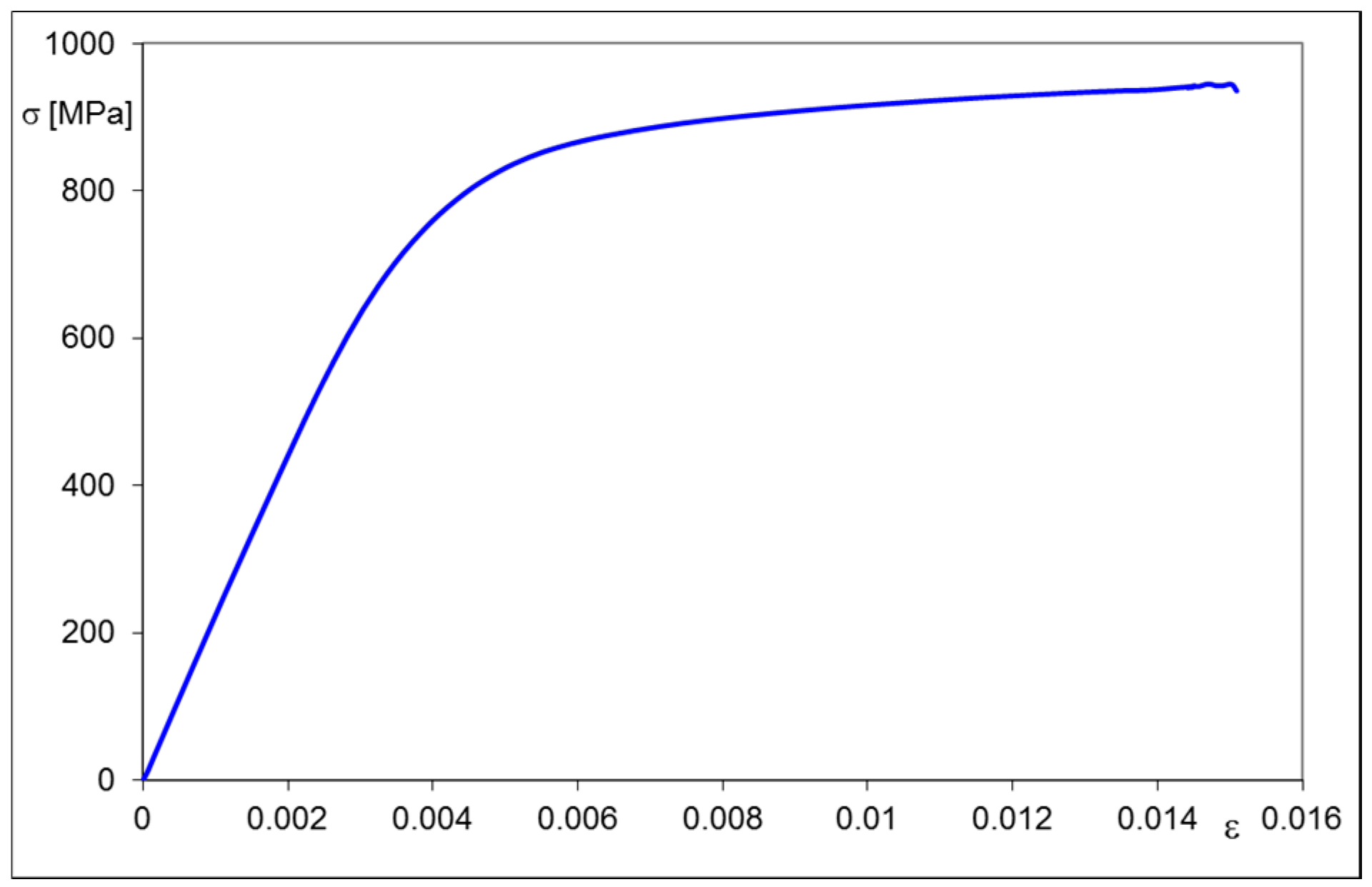
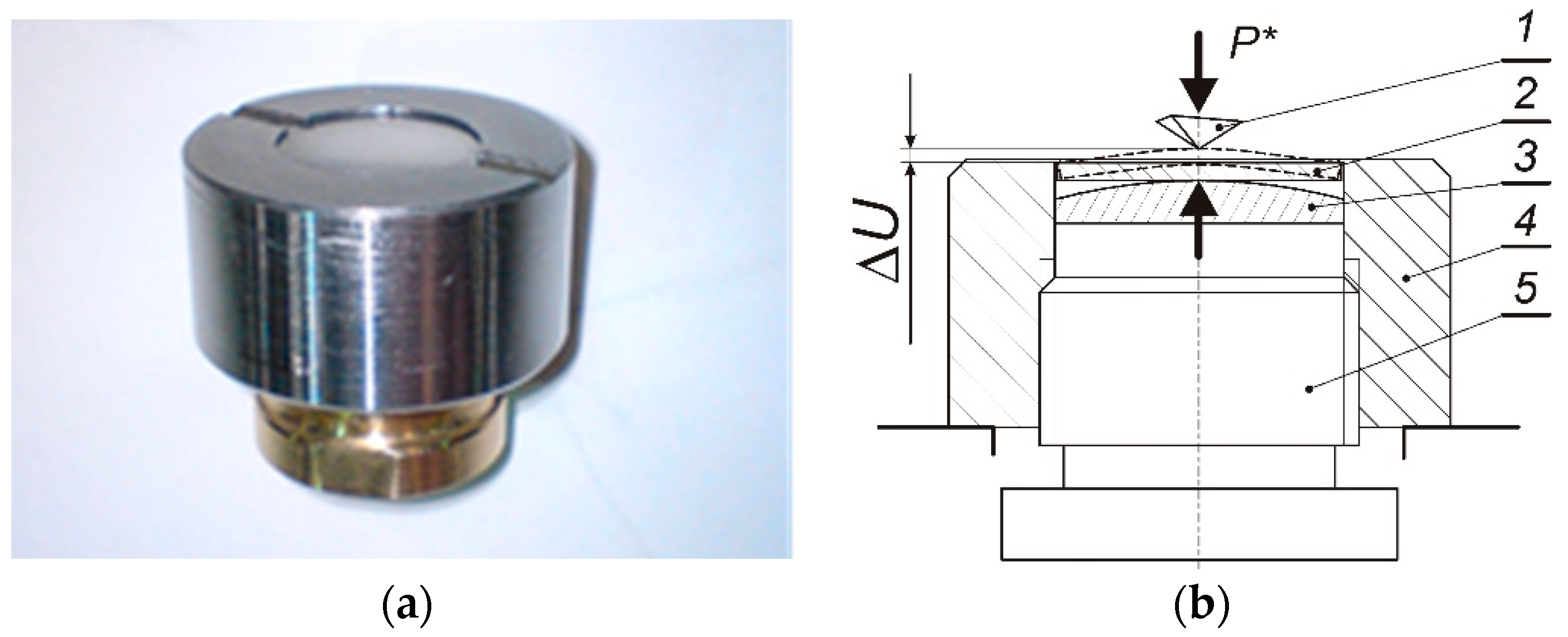
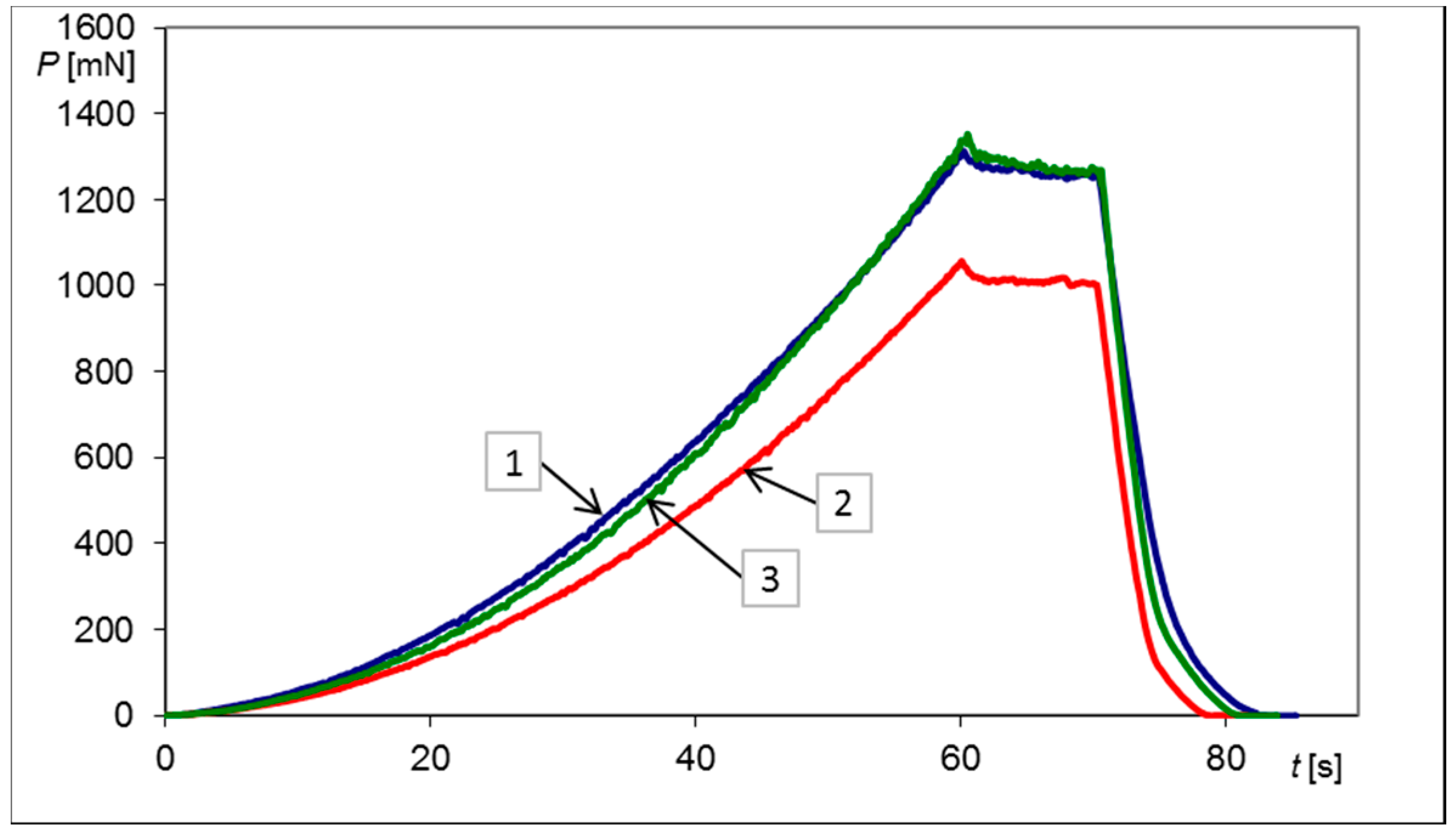
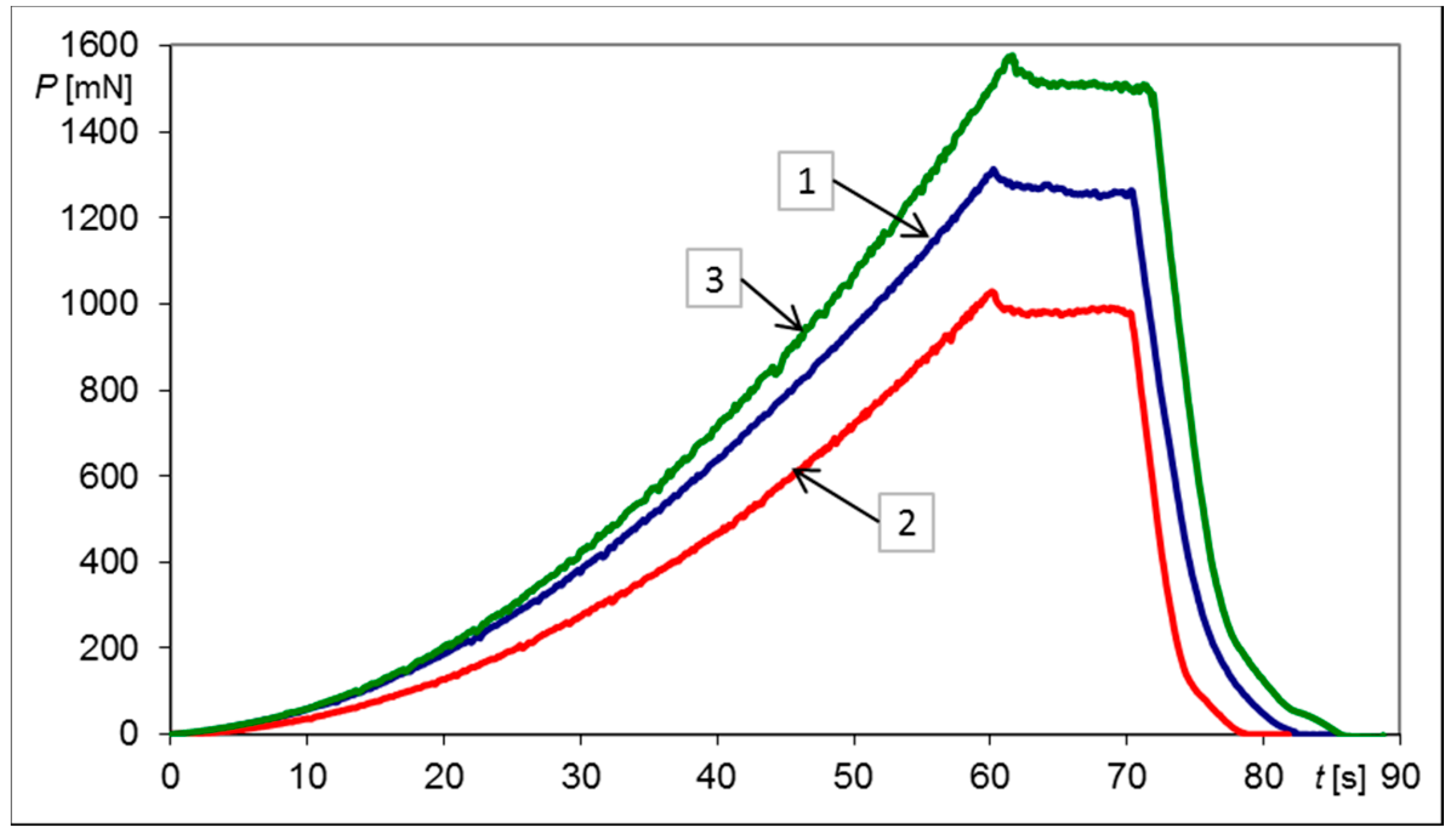
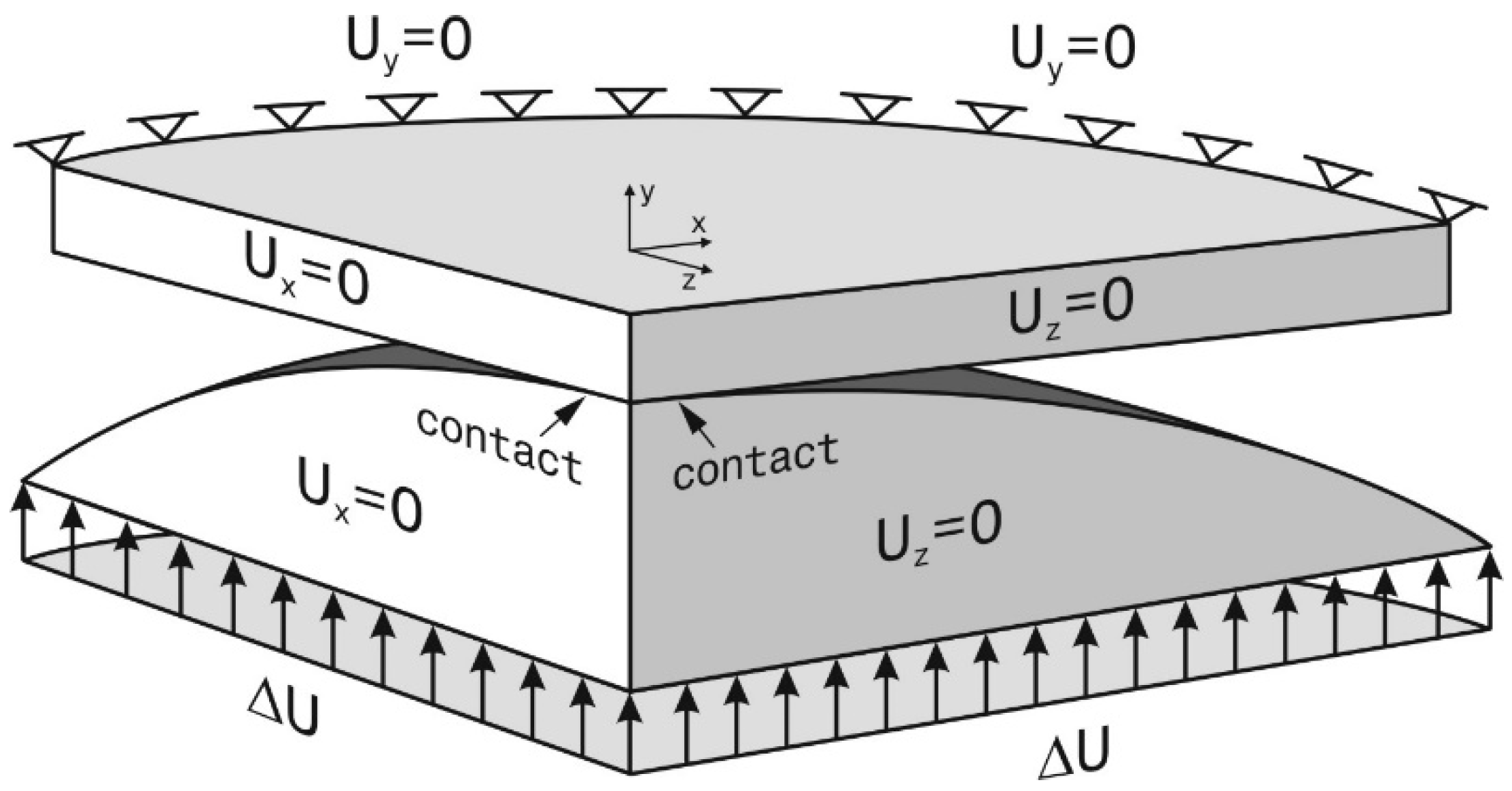
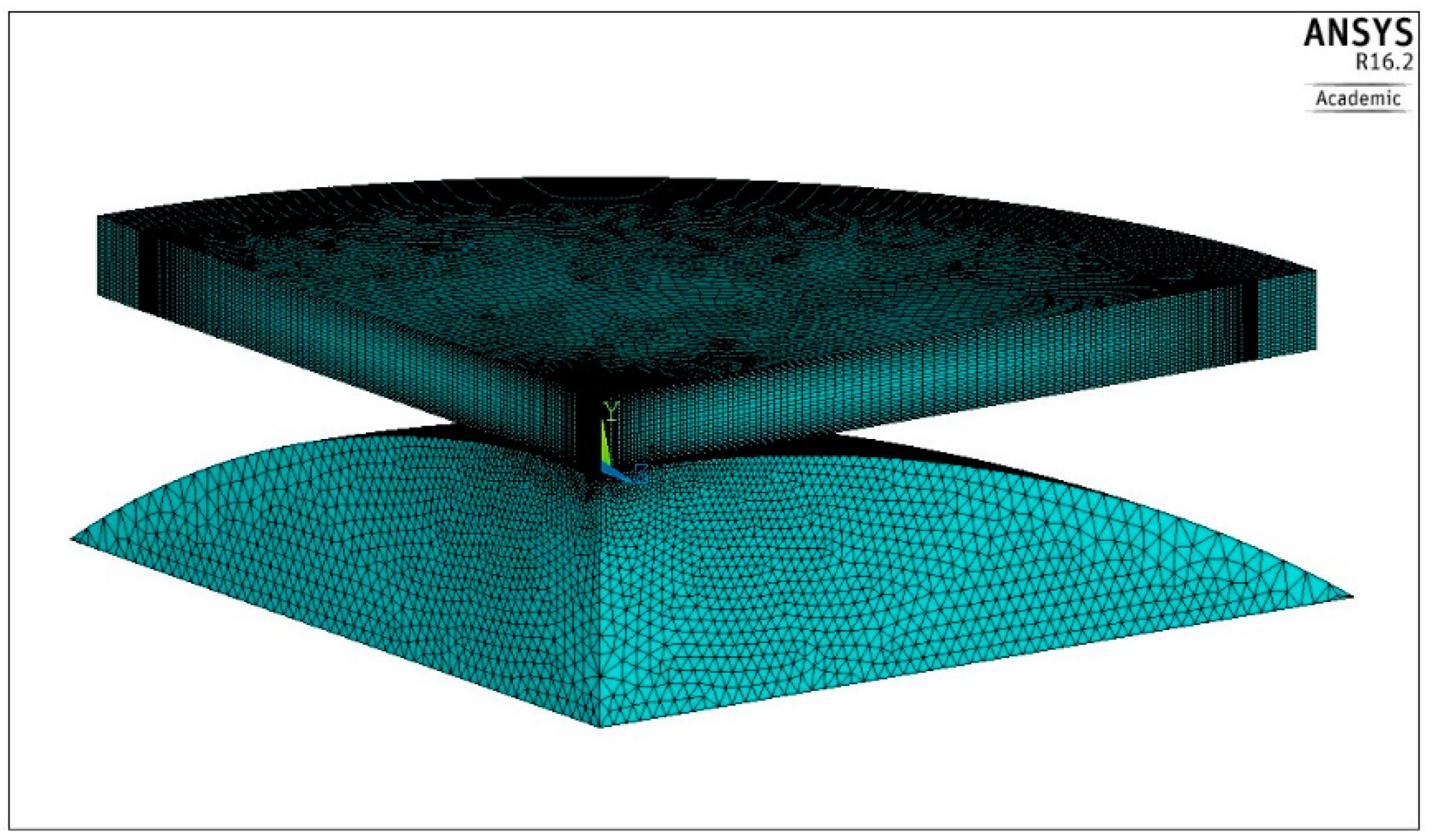

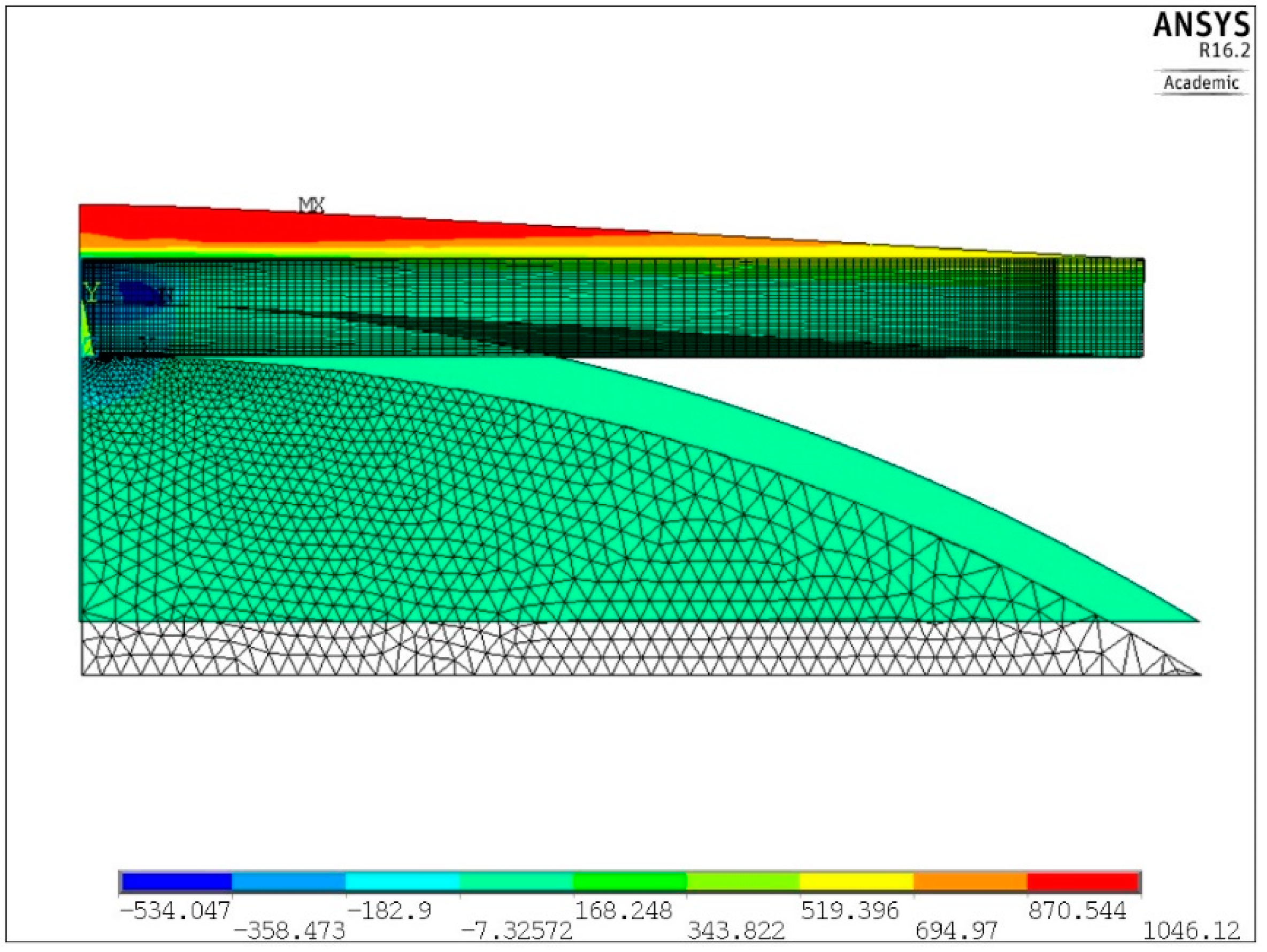
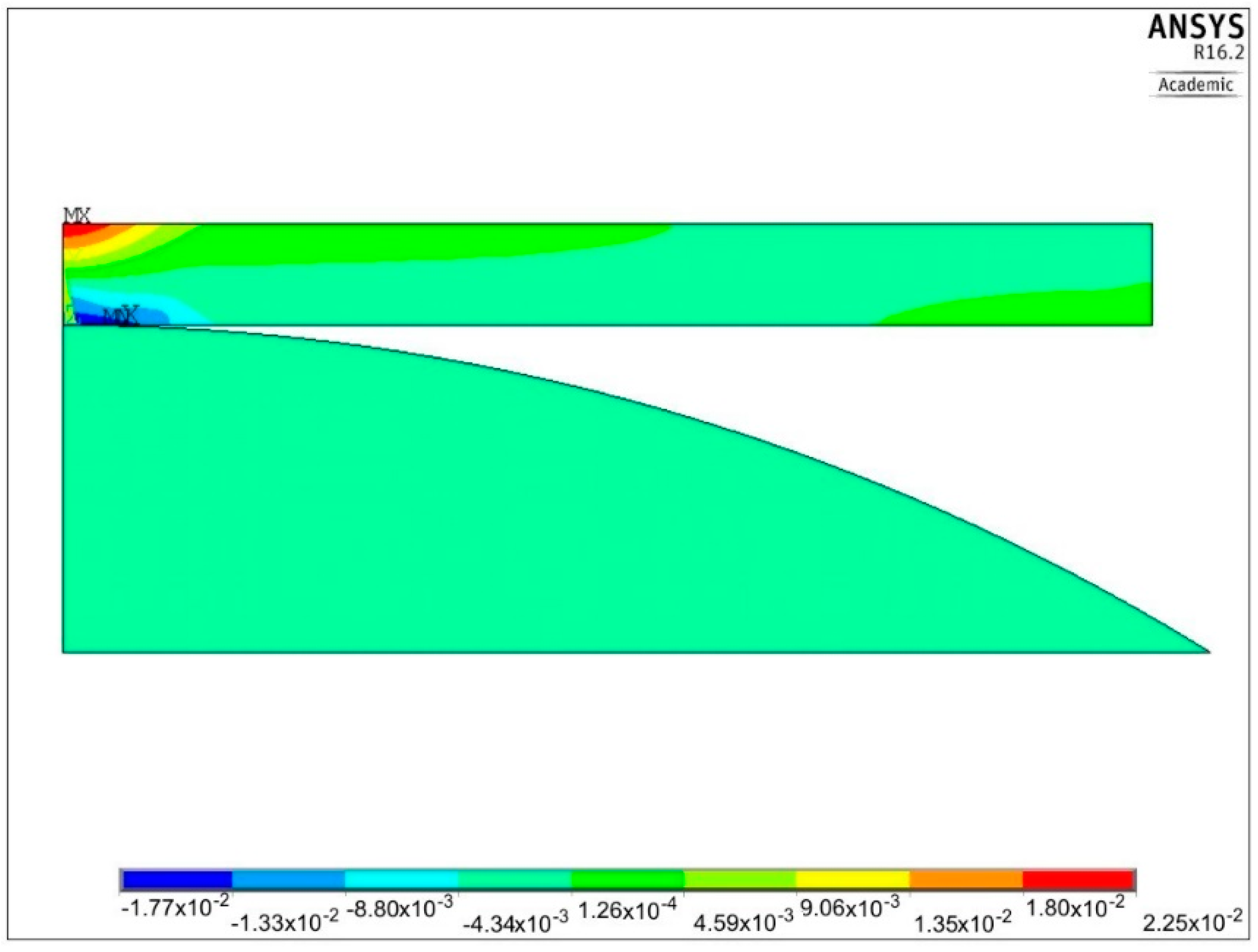
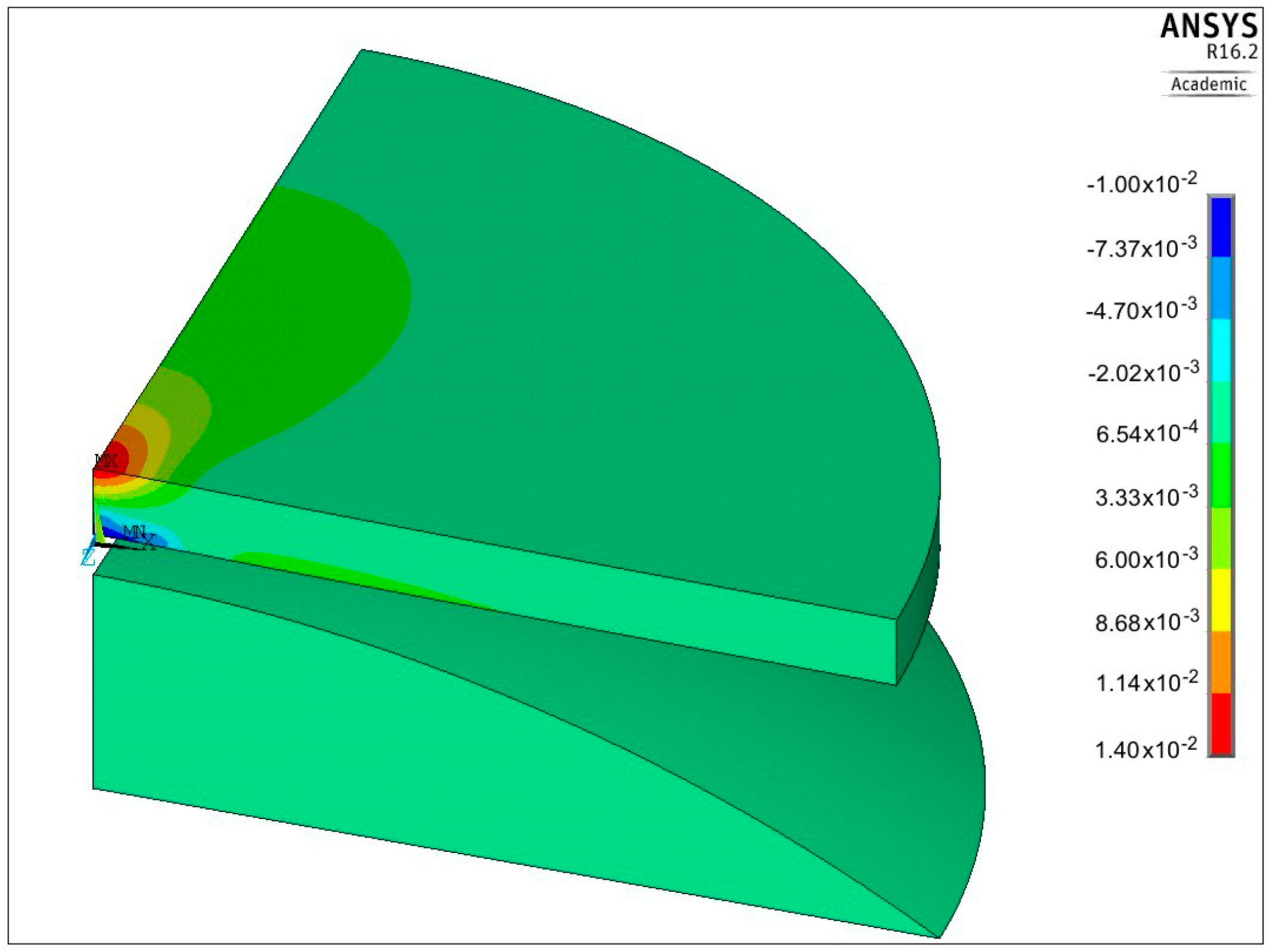
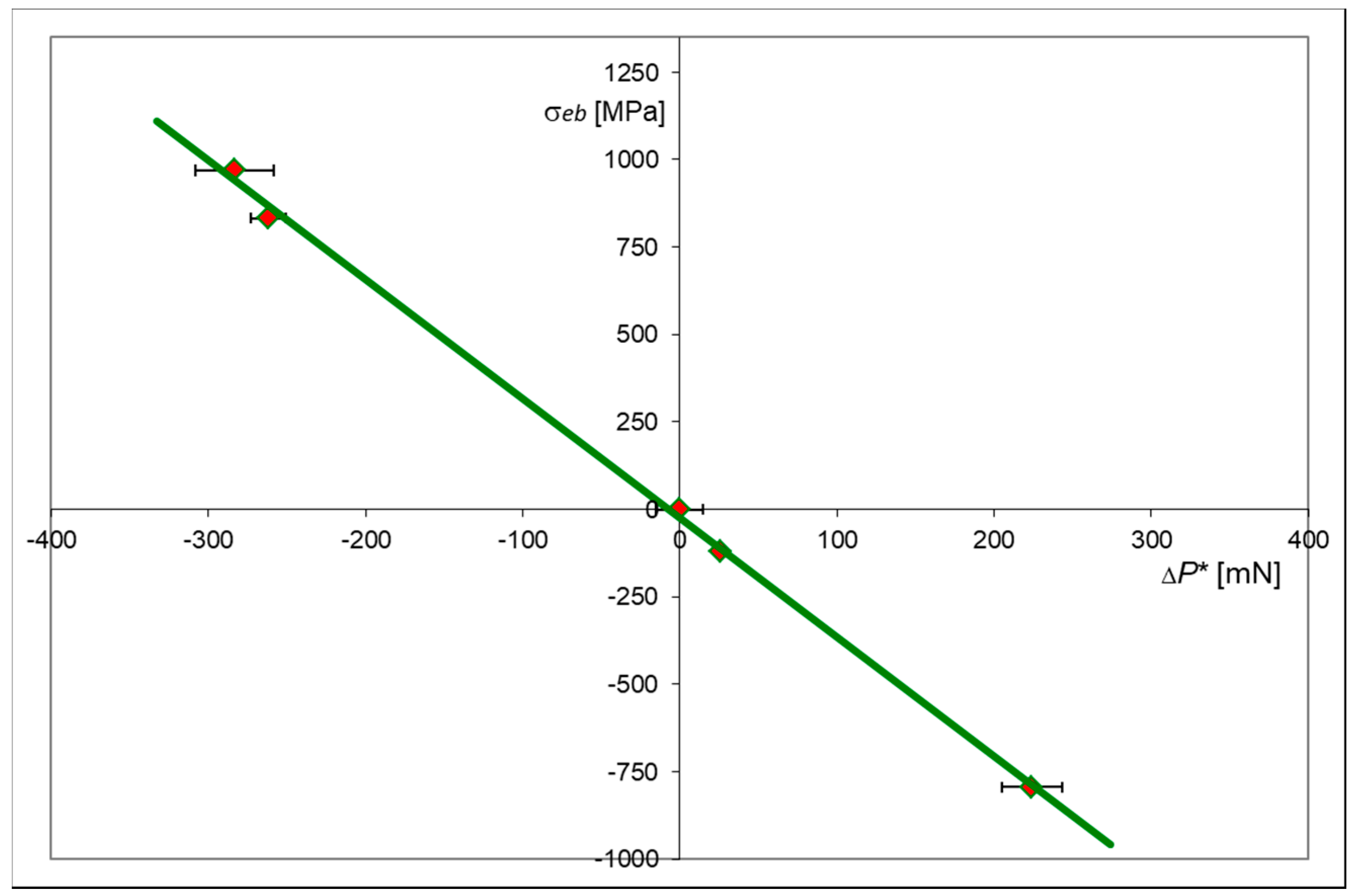
| Quantity | Units | Initial State | First Loading Semi-Cycle | First Unloading Semi-Cycle | Second Loading Semi-Cycle | Second Unloading Semi-Cycle |
|---|---|---|---|---|---|---|
| i-th semi-cycle | – | 0 | 1 | 2 | 3 | 4 |
| ΔUi | μm | 0.0 | 81.8 | 22.3 | 334.2 | 136.4 |
| Pi* | mN | 1259.5 | 997.5 | 1285.1 | 976.4 | 1483.6 |
| Std. Dev. Pi* | mN | 22.0 | 15.1 | 19.3 | 11.3 | 25.0 |
| ΔPi* | mN | 0.0 | −262.0 | 25.6 | −283.1 | 224.1 |
| HIT | MPa | 3403.8 | 2559.8 | 3283.1 | 2508.2 | 3912.6 |
| Std. Dev. HIT | MPa | 137.9 | 115.5 | 44.3 | 82.9 | 213.0 |
| i-th Semi-Cycle | 1 | 2 | 3 | 4 |
|---|---|---|---|---|
| σeb | 833 MPa | −119 MPa | 969 MPa | −793 MPa |
| ΔPi* | −262.0 MPa | 25.6 MPa | −283.1 MPa | 224.1 MPa |
Publisher’s Note: MDPI stays neutral with regard to jurisdictional claims in published maps and institutional affiliations. |
© 2020 by the authors. Licensee MDPI, Basel, Switzerland. This article is an open access article distributed under the terms and conditions of the Creative Commons Attribution (CC BY) license (http://creativecommons.org/licenses/by/4.0/).
Share and Cite
Hościło, B.; Molski, K.L. Determination of Surface Stresses in X20Cr13 Steel by the Use of a Modified Hardness Measurement Procedure with Vickers Indenter. Materials 2020, 13, 4844. https://doi.org/10.3390/ma13214844
Hościło B, Molski KL. Determination of Surface Stresses in X20Cr13 Steel by the Use of a Modified Hardness Measurement Procedure with Vickers Indenter. Materials. 2020; 13(21):4844. https://doi.org/10.3390/ma13214844
Chicago/Turabian StyleHościło, Bogusław, and Krzysztof L. Molski. 2020. "Determination of Surface Stresses in X20Cr13 Steel by the Use of a Modified Hardness Measurement Procedure with Vickers Indenter" Materials 13, no. 21: 4844. https://doi.org/10.3390/ma13214844




